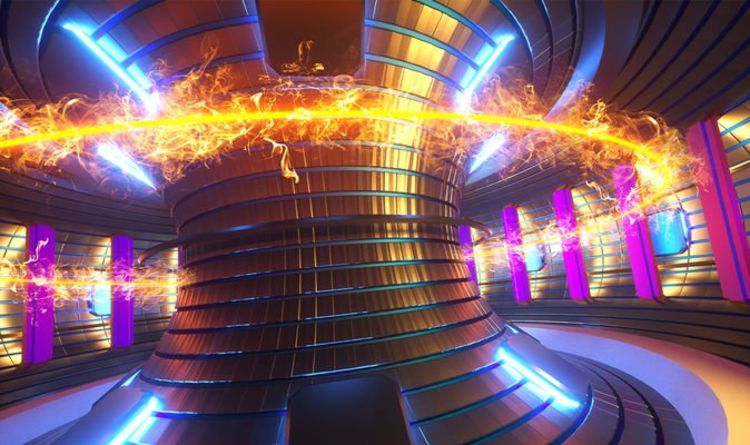
Korean Artificial Sun Hits 100 Million Degrees Celsius For 20 Seconds, Sets Earth Record
Share
Korea's Superconducting Tokamak Advanced Research (KSTAR) fusion device - or Korea's artificial sun - hit a new record after succeeding in maintaining a high ion plasma temperature over 100 million degrees Celsius for 20 seconds late last year.
The KSTAR Research Center at the Korea Institute of Fusion Energy (KFE) announced that in a joint research with the Seoul National University (SNU) and Columbia University of the United States, it succeeded and ticked one box off the core conditions of nuclear fusion in the 2020 KSTAR Plasma Campaign.
The first 100 million degree Celsius benchmark was made by the KSTAR Plasma Campaign in 2018 (albeit for only 1.5 seconds) and in 2019, it made an 8 second plasma operation time.
But this recent effort made more than double that time and beat it own records handily.
How?

It's Clintern here. this isn't it, I just reckon it looks cool.
To mimic the power of the sun on Earth, and it's nifty fusion reactions, hydrogen isotopes are placed inside a fusion device (like KSTAR) to create a plasma state where ions and electrons are separated. But to do this, ions must be heated and maintained at astronomical temperatures, literally.
Although other fusion devices have managed plasma at the 100 million degree Celsius benchmark, none have broken the 10 second time frame until now.
The requirements for housing stable plasma in the fusion device at that temperature have proven difficult for any substantial amount of time.
What makes KSTAR different is the recent improvement of the Internal Transport Barrier (ITB) performance, one of the next-gen operation modes developed in 2019 and succeeded in keeping the plasma stable for longer.
Director Si-Woo Yoon of the KSTAR Research Center at the KFE explained, "The technologies required for long operations of 100 million- plasma are the key to the realization of fusion energy, and the KSTAR's success in maintaining the high-temperature plasma for 20 seconds will be an important turning point in the race for securing the technologies for the long high-performance plasma operation, a critical component of a commercial nuclear fusion reactor in the future."

KSTAR: Korea's Superconducting Tokamak Advanced Research fusion device
"The success of the KSTAR experiment in the long, high-temperature operation by overcoming some drawbacks of the ITB modes brings us a step closer to the development of technologies for realization of nuclear fusion energy," added Yong-Su Na, professor at the department of Nuclear Engineering, SNU, who has been jointly conducting the research on the KSTAR plasma operation.
Dr. Young-Seok Park of Columbia University who contributed to the creation of the high temperature plasma said: "We are honored to be involved in such an important achievement made in KSTAR. The 100 million-degree ion temperature achieved by enabling efficient core plasma heating for such a long duration demonstrated the unique capability of the superconducting KSTAR device, and will be acknowledged as a compelling basis for high performance, steady state fusion plasmas."
The KSTAR began operating the device last August and plans to continue its plasma generation experiment until December 10, conducting a total of 110 plasma experiments that include high-performance plasma operation and plasma disruption mitigation experiments, which are joint research experiments with domestic and overseas research organizations.
In addition to the success in high temperature plasma operation, the KSTAR Research Center conducts experiments on a variety of topics, including ITER researches, designed to solve complex problems in fusion research during the remainder of the experiment period.
The KSTAR is going to share its key experiment outcomes in 2020 including this success with fusion researchers across the world in the IAEA Fusion Energy Conference which will be held in May.
The final goal of the KSTAR is to succeed in a continuous operation of 300 seconds with an ion temperature higher than 100 million degrees by 2025.
KFE President Suk Jae Yoo stated, "I am so glad to announce the new launch of the KFE as an independent research organization of Korea. The KFE will continue its tradition of undertaking challenging researches to achieve the goal of mankind: the realization of nuclear fusion energy," he continued.
As of November 20, 2020, the KFE, formerly the National Fusion Research Institute, an affiliated organization of the Korea Basic Science Institute, was relaunched as an independent research organization.
Yo yo it's me Clint the Intern!
Our 3 pack of pins are perfect for your hat or jacket lapel for when you really want to spread ARSE but feel like wearing something a bit different.
PS: turns out I left Tasmania off of Australia, so since it makes up 0.9% of Australia i've discounted the pins accordingly. 12 cents off while stocks last!!!!!!
Limited Quantity - Available While Stocks Last!
Do you think the journey to fusion on Earth is worth it?
More of a cold fusion type?
Let us know in comments and share to help spread ARSE.
#Space_Aus





